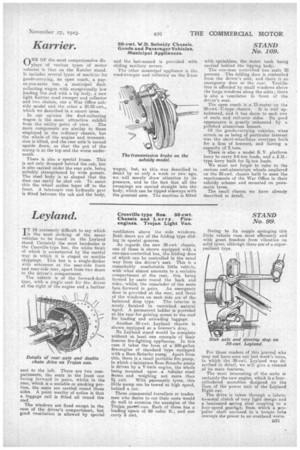Leyland.
Page 25

If you've noticed an error in this article please click here to report it so we can fix it.
Crosville-type Bus. 30-cwt. Chassis and Lorry. Fireengines. Trojan Light Van,
STAND No. 99.
IT. IS extremely difficult to say which is the most striking of the many vehicles to he found on the Leyland stand. Certainly the most handsome is the Crosville-type bus, the white finish of which is accentuated by the careful way in which it is staged on marble chippings. This bus is a single-decker with entrances at the near-side front. and near-side rear, apart from. two doors to the driver's compartment. The vehicle is of the forward-dash type, with a single seat for the driver at the right of the engine and a further seat to the left. There are two compartments, the seats in the front one facing forward in pairs, whilst, in the rear, which is a sociable or smoking portion, the seats are carried round three sides. A point worthy of notice is that a luggage rail is fitted all round the roof.
The windows are fixed except in the case of the driver's compartment, but good ventilation is allowed by special ventilators above the side windows. Both doors are of the folding type sliding in speeial grooves.
As regards the new 30-cwt. chassis, one of these is shown equipped with a one-men-controlled bus, the folding door of which can be controlled in the usual way from the driver's seat. This is a remarkably comfortable little vehicle, with what almost amounts to a sociable compartment at the rear, this being formed by seats round the hack and sides' -whilst the remainder of the seats face forward in pairs. An emergency door is provided at the rear, and three of the windows on each side are of the
balanced drop type. The interior is nicely finished in varnished natural argod. A permanent ladder is provided at the rear for gaining access to the roof for loading and unloading luggage.
Another 30-cwt. Leyland chassis is shown equipped as a brewer's dray.
No Leyland stand would be complete without at least one example of their famous fire-fighting appliances. In this case it takes the form of a'500-gallon fire-engine of standard type equipped with a Rees-Roturbo pump. Apart from this, there is a small portable fire pump, in which a miniature Rees-Roturbo pump is driven by a V-twin engine, the whole being mounted upon a tubular steel frame and weighing not more than
2i cwt. With pneumatic tyres, this little pump can be towed at high speed, behind a car.
Those commercial travellers or tradesmen who desire to cut their costs would do well to examine the examples of the Trojan part-van. Each of these has a loading space of 60 cubic ft., and can carry 5 cwt.
Owing to its supple springing this little vehicle runs most efficiently and with great freedom from vibration on solid tyres, althofigh these are of a superresilient type.
For those readers of this journal who may not have .seen our last week's issue, in which the 30-cwt. Leyland was described in detail, we will give a resume of its main feathres.
The most interesting of the units is certainly the new engine, which is a fourcylindered monchloc designed on the lines of the power unit of the Leyland Eight car.
The drive is taken through a fabricto-metal clutch of very light design and a laminated spring steel coupling to a four-speed gearbex from which a propeller shaft enclosed in 'a torque tube conveys the power to an overhead worm.








































































